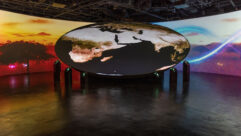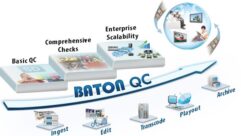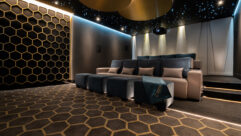
AV Creates Immersive Experience
The 260-degree video projection screens in Decision Theater at Arizona State University enable visualization, collaboration, and simulation.
The Biodesign Institute’s display wall, which is visible from the exterior of the building, is comprised of 18 Clarity Visual Systems 46-inch Baycat X LCD panels mounted in a two-by-nine configuration.
CHALLENGE: Create a virtual space where academic, community, and government decision-makers can use high-resolution visualization and 3D simulation to solve critical issues.
SOLUTION: Erect a purpose-built theater featuring 260-degree video screens, 5.1 surround sound audio, and multiple shared resources — all handled by a simple control interface.
LIKE MANY future-forward projects, the AV systems in the Decision Theater at Arizona State University (ASU) required expertise in several areas of AV design and installation. Unlike more traditional theaters built for live performances, Decision Theater’s unique proposition is its 260-degree immersive AV system, which is capable of interactive graphics and 3D visuals.
ADVANCED VISUALIZATION SYSTEMS
The advanced visualization system from Fakespace, a Marshalltown, IA-based advanced visualization solutions provider and integrator, creates a very vivid, realistic experience in the Decision Theater at Arizona State University (ASU) in Tempe. Each Digital Projection HIGHlightPro projector is 1400×1050 pixels, which produces a total of nearly 10,000,000 pixels across the theater’s seven projection screens.
The Stereo-ready DLP projectors, are capable of the higher 96 Hz refresh rate required for active stereo viewing. In active stereo projection, a single projector draws both the right and left eye images.
A StereoGraphics Projection ZScreen is mounted over the projector lens, and acts like a liquid crystal modulating panel that allows theater users to view their data in active or passive stereo mode. To create a sense of total immersion during active stereo viewing, polarized or synchronized shutter glasses are worn to make the eyes believe that they’re actually seeing a single image. For extended viewing, passive stereo is often used with the appropriate eyewear. Finally, edge matching — the graphical adjustment of two images that appear as one when matched — is added between the screens to complete the experience.
According to Fakespace Account Manager Brent Redman, Decision Theater’s system also uses an Intersense tracking system that’s integrated into the visualization system to track the user’s movement within the graphics. “Strips of sensors were installed overhead, and the user is tracked by wearing a head tracking device or holding a wand,” he says. “This allows the user to move within the presentation.”
The theater now stands in the heart of a revitalized area of mixed retail, residential, commercial, and educational space in the downtown Tempe area. ASU President Michael Crowe’s vision for the university included the high-tech theater that was made possible by a $3 million donation from Ira Fulton, a local home builder and philanthropist. ASU accepted the gift in November 2004 with the commitment to open Decision Theater by May 2005, and matched the gift with another $3 million.
“His gift jump-started the project from construction to AV,” says Rick Shangraw, executive director of Decision Theater. “When I joined on in February 2005, they had already put together architectural plans since the deadline was coming fast. The president felt there was no need to delay with the money and concept in hand.”
As executive director, Shangraw’s responsibilities include managing, promoting, and overseeing operations for the theater. “The real purpose of the theater is to help decision-making,” he says. “We merge visualization, collaboration, and simulation to look at problems facing government and industry. Decision-makers also have access to the scientific and engineering expertise at ASU.”
Typically, leadership groups will plan a half-day session to meet in the theater, with several more meetings planned across several months. Whether the issue is suburban sprawl or transportation systems planning or global warming, groups can use the installed AV systems to visualize the future through alternative, interactive scenarios.
To create and manage this virtual world, ASU worked with David Barazoto, vice president of sales at AV integration firm Technology Providers Inc. (TPI) of Chandler, AZ. Using their combined strengths, TPI won the project bid with strategic partner Fakespace, a Marshalltown, IA-based advanced visualization solutions provider and integrator. “We had 90 days to complete the project due to construction delays, with a hard deadline for the grand opening in May 2005,” Barazoto says.
TPI dealt with the usual power and structural issues, while Fakespace handled the projector and screen installations, system calibration, and acquiring special equipment for the project, including new short-throw lenses for the projectors.
Near-total immersion
Prior to the installation, Account Manager Brent Redman and his team at Fakespace assembled a smaller three-screen version for a test run to review the system. TPI and ASU flew out to Fakespace’s Marshalltown facility to experience it for the first time, and work out any questions or problems.
FOR MORE INFORMATION
- AMXwww.amx.com
- ClearOnewww.clearone.com
- Dellwww.dell.com
- Digital Projectionwww.digitalprojection.com
- Extronwww.extron.com
- Intersensewww.isense.com
- JBLwww.jblpro.com
- MediaSonicwww.mediasonic.com
- NECwww.necvisualsystems.com
- QSC Audiowww.qscaudio.com
- StereoGraphicswww.stereographics.com
- Stewart Filmscreenwww.stewartfilmscreen.com
- Tandbergwww.tandberg.net
For the final installation, which includes seven screens, TPI used five-conductor coax, high-resolution RGB cable for all of the cable runs. Although the longest cable run was only 100 feet, the theater’s raised floor system made the cable runs even easier. TPI also reviewed power loads and worked with the electrical contractor to ensure that each projector had its own 20-amp circuit.
A total of seven 100-foot-wide by 75-foot-tall VE Series Stewart Filmscreen projection screens comprise the 260-degree viewing experience. Seven Digital Projection HIGHlightPro SXGA+ projectors, which shoot images from behind the screens, are tucked in between structural columns that surround the circular room. Due to the short 15-foot throw, Digital Projection also provided 1:1 short-throw lenses, which were made for a 4:3 aspect ratio image, that weren’t yet available to the market at the time.
While the walls were designed and built specifically to accommodate the screens, the columns in the rear-projection area were unforeseen. As a result, some of the projectors had less than 6 inches of clearance, which is out of spec for the product. “The projector would be venting in its own exhaust,” Barazoto says. “TPI and Fakespace worked together to build a custom fan solution for proper ventilation.”
The projection system runs high-resolution graphics and video using an eight-node Dell PC cluster running on a Linux OS. A single PC is used for each projector, plus one master PC that serves as the main user interface. All of the PCs run into an Extron CrossPoint Plus 32×16 HVA matrix switcher that enables users to send signals from three MediaSonic media servers housing custom content.
“We fabricate very little custom equipment, and typically buy equipment off the shelf for our solutions,” Redman says. “What makes our systems unique are our software programs for advanced visualization, and our knowledge of how the hardware components work well together to give our customers a complete visualization solution.”
JBL Control 26C ceiling speakers powered by QSC CX254 amplifiers were used to provide quality audio for the presentations. Presenters also have a choice of several models of wired and wireless Shure microphones to use.
User-friendly control
Once the projectors were up and running, Fakespace completed a bit of control programming before passing it along to TPI. A Fakespace programmer remained onsite to help TPI with any issues. “It was a challenge of making all the pieces work in a complex but highly flexible system, Shangraw says, who worked closely with TPI on all aspects of the control system. “At any time, we must be able to deliver a production-quality demonstration for people touring ASU. Over the last year, we hosted about 6,000 people who came through the theater. We’re often the face of ASU, so there can’t be any glitches.”
In addition, because students would serve as system operators in the production control room, the control programming had to be simple and straightforward. The Decision Theater AMX system consists of a dedicated NetLinx NI-3000 integrated controller and a TPI/4 touchpanel interface. The system controls nearly all of the technology used in the theater, including the projectors, AV source switching, lighting, and temperature.
Everything the AMX system controls can be accessed using three buttons or less on the touchpanel. The user doesn’t have to dig through several layers of menus or pop-up pages, which prevents frustration and user fatigue. Barazoto credits the use of macros in the programming. “We simplified the system using ‘routines’ — the procession of events for a certain setup — which were recorded using a macro,” he says. “This preserved the order of setup and kept button-pushing to a minimum.”
Shangraw says the presentations in Decision Theater are similar to a carefully choreographed Broadway production. “My staff must coordinate input from a number of different devices to facilitate a very complex demonstration, and it’s essential that they be able to work very quickly between different input and output sources,” he says. “The AMX system enables them to do this.”
Shared resources
In addition to the main theater, the building includes two meeting rooms and a lobby that are also equipped with AV gear. In the lobby, a digital signage system made up of seven NEC PX Series plasma displays provide incoming guests with custom video content. In the executive conference room, a full Tandberg 6000 videoconferencing codec and ClearOne audioconferencing DSP is available. The large conference room can be configured as one large, private space or divided into two smaller rooms. Depending on the room’s configuration, the AMX system automatically chooses which AV components to activate.
Decision Theater’s AMX NetLinx NI-3000 integrated controller and TPI/4 touchpanel interface control nearly all of the technology used in the theater, meeting rooms, and lobby, including the projectors, AV source switching, lighting, and temperature. Because students serve as system operators in the control room, each function can be accessed using three buttons or less.
A second AMX NetLinx NI-3000 integrated controller in the executive conference room controls the AV in all three rooms. Additionally, an 8.4-inch wireless AMX Modero ViewPoint touchpanel is installed in each room for added mobility and convenience. “There are multiple shared resources across all rooms,” Barazoto says. “Users can share things like the videoconferencing codec or DirecTV signal one room at a time. Secure transmission isn’t an issue because the theater is off the network from the rest of ASU.”
Barazoto says choosing the right AV equipment was essential to ensuring that the theater’s new AV system would be as user-friendly as possible. “Based on our experience, some products don’t provide good feedback information to the system, but this isn’t an issue at Decision Theater,” he says.
Linda Seid Frembes is a freelance writer and public relations consultant for the professional AV industry. She can be reached at [email protected].









